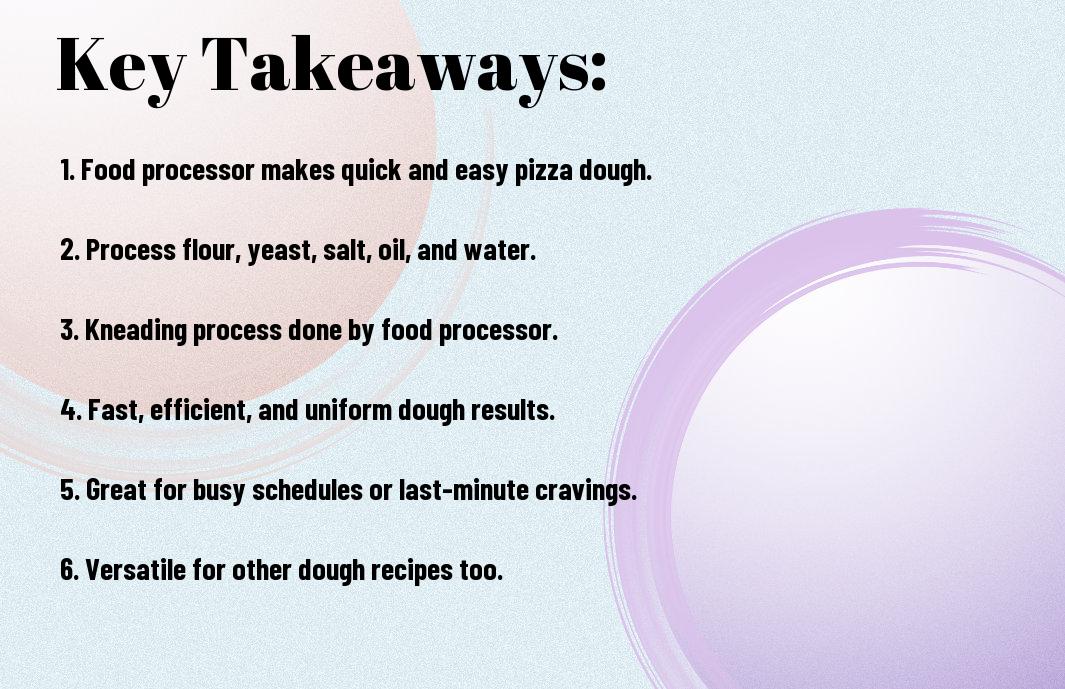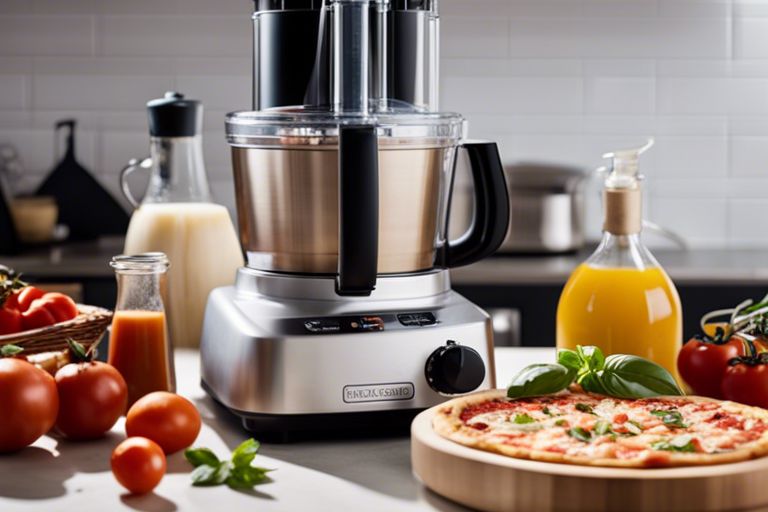Just like a culinary superhero, a food processor can save the day when it comes to making pizza dough. In this guide, we’ll walk you through the steps of using this versatile kitchen tool to effortlessly create the perfect pizza dough that will have your taste buds singing.
Key Takeaways:
- Efficiency: Using a food processor can save time and effort when making pizza dough, as it quickly combines the ingredients without the need for manual kneading.
- Consistency: The food processor ensures a more consistent dough texture by evenly mixing and kneading the ingredients, resulting in a better pizza crust.
- Versatility: Beyond pizza dough, a food processor can be a versatile tool in the kitchen for various recipes requiring dough preparation, making it a worthwhile investment for home cooks.

The Basics of Pizza Dough
What Makes Good Pizza Dough
For an authentic and delicious pizza experience, good pizza dough is key. The key components of good pizza dough are simple – flour, water, yeast, salt, and olive oil. The quality of your ingredients and the right ratios are crucial to creating the perfect dough. A good dough should be elastic, easy to work with, and have the right balance of chewiness and crispiness once baked.
Traditional Methods of Making Pizza Dough
Pizza has been a beloved dish for centuries, and traditional methods of making pizza dough have been passed down through generations. Making pizza dough by hand is a time-honored process that involves mixing the ingredients, kneading the dough until it is smooth and elastic, and allowing it to rise before shaping and baking it. This hands-on approach allows for a deep connection with the food and a sense of satisfaction in creating something delicious from scratch.
Another traditional method of making pizza dough is using a stand mixer with a dough hook attachment. This method can save time and effort compared to kneading by hand, but still allows for a hands-on approach to creating the perfect dough.
Can a Food Processor Really Help?
The Role of a Food Processor in Dough Making
Food processors are a game-changer when it comes to making pizza dough. These versatile machines are designed to handle the tough work of mixing and kneading dough, which can be quite labor-intensive when done by hand. By using a food processor, you can quickly and efficiently bring your dough together without breaking a sweat.
Advantages of Using a Food Processor
Really, the main advantage of using a food processor for pizza dough is the time and effort it saves. Instead of spending precious minutes kneading and mixing by hand, a food processor can do the job in a fraction of the time. This is especially helpful for busy home cooks or those with limited kitchen space.
The food processor’s sharp blades can cut through the ingredients with precision, ensuring an evenly mixed dough every time. Additionally, the controlled environment of the food processor can help regulate the temperature of the dough, which is crucial for a successful rise.
Ingredients and Equipment Needed
Essential Ingredients for Pizza Dough
On your quest to make the perfect pizza dough using a food processor, you will need some necessary ingredients. These typically include flour, water, yeast, salt, and a bit of olive oil. The quality of your ingredients can greatly impact the final result, so opt for high-quality flour and fresh yeast for the best dough.
Food Processor Settings and Accessories
On your journey to pizza perfection, understanding your food processor settings and accessories is key. Different food processors come with varying blade options and speeds. For pizza dough, it’s recommended to use the standard blade attachment and pulse function to mix the ingredients until they form a ball of dough.
An important accessory to consider is the feed tube size of your food processor. A wider feed tube allows for easier addition of liquids while the machine is running, which can be useful when slowly incorporating water into your dough mixture.
Essential Tips for Making Pizza Dough
Essential to making pizza dough in a food processor is to ensure all your ingredients are well-measured and at the correct temperature. The water you use should be lukewarm to activate the yeast properly, and the salt should be incorporated evenly throughout the flour before adding the liquid ingredients. By following these necessary tips, you’ll be on your way to delicious homemade pizza crust in no time!
Step-by-Step Guide to Making Pizza Dough in a Food Processor
All pizza lovers know that the key to a perfect pie lies in the dough. Making pizza dough from scratch may sound intimidating, but with the help of a food processor, it becomes a breeze. Follow this step-by-step guide to learn how to make delicious pizza dough using your food processor.
| Initial Mixing and Kneading | Developing Gluten and Resting the Dough |
MakingStart by adding all your dry ingredients to the food processor and pulse a few times to combine. Then, slowly pour in the warm water while the processor is running until the dough comes together. Let it process for about a minute until the dough forms a ball. |
DoughAfter the initial mixing, transfer the dough to a lightly floured surface and knead it by hand for a few minutes. This step helps develop gluten in the dough, giving it structure and elasticity. Once you’ve kneaded the dough, cover it with a damp cloth and let it rest for about 30 minutes. |
Another important step in the pizza dough-making process is to let the dough rest after kneading. This resting period allows the gluten to relax and the dough to hydrate fully, making it easier to shape later on.
Shaping and Proofing the Dough
One the dough has rested, it’s time to shape it into a ball and let it proof. Shape the dough by gently stretching and tucking the edges underneath to form a smooth ball. Place the dough in a lightly oiled bowl, cover it with a kitchen towel, and let it proof for at least an hour, or until it has doubled in size.
Dough that has been properly shaped and proofed will be easier to roll out and will result in a light and airy crust once baked. This step is crucial for achieving that perfect pizzeria-style dough at home.

Tips and Tricks for Success
Your pizza dough making experience can be greatly improved by following these tips and tricks:
- Use cold water when adding liquid to the food processor to prevent the dough from becoming too warm.
- Pulse the food processor on and off rather than running it continuously to prevent overheating the dough.
- Allow the dough to rest and rise properly after processing to develop better flavor and texture.
Any leftover pizza dough can be stored in the fridge for future use, just make sure to let it come to room temperature before shaping and baking.
Common Mistakes to Avoid
One common mistake when making pizza dough in a food processor is overworking the dough, which can result in a tough crust. Be sure to pulse the ingredients just until they come together to avoid this issue. Another mistake is adding too much flour, which can make the dough dry and hard to work with.
Optimizing Your Food Processor for Dough Making
Tips for optimizing your food processor for making dough include using the plastic dough blade attachment if your model has one, as it is designed specifically for dough mixing. For instance, check the capacity of your food processor to ensure it can handle the amount of dough you are making.
Variations and Experimentation
Adding Flavorings and Herbs to Your Dough
Dough can be a blank canvas for your culinary creativity. Experiment with adding different flavorings and herbs to your pizza dough to give it a unique twist. Consider mixing in ingredients like garlic powder, dried oregano, basil, or even red pepper flakes for a kick of heat. The possibilities are endless, so don’t be afraid to get creative and try out different combinations until you find your perfect flavor profile.
Using Different Types of Flour and Yeast
Dough made with all-purpose flour is classic, but why not switch things up and experiment with different types of flour such as whole wheat, bread flour, or even gluten-free flour to cater to dietary preferences or simply for a change in texture and flavor. As far as yeast, you can try using instant yeast, active dry yeast, or even sourdough starter for a unique tangy flavor profile. Recognizing how different flours and yeasts affect the final product can help you tailor your pizza dough to suit your preferences.
| Flour Type | Yeast Type |
|---|---|
| Whole Wheat | Instant Yeast |
| Bread Flour | Active Dry Yeast |
| Gluten-Free Flour | Sourdough Starter |
| 00 Flour | |
| Semolina Flour |
Adding subtle flavors to your dough can really elevate your pizza game. Consider experimenting with ingredients like honey for a touch of sweetness, or even a bit of beer for a unique flavor profile. Fresh herbs like rosemary, thyme, or even chopped fresh garlic can add a burst of freshness to your dough. Keep in mind, a little experimentation can go a long way in creating a pizza dough that is uniquely yours.
Final Words
To wrap up, making pizza dough in a food processor is not only possible but also a convenient and efficient way to achieve a delicious homemade pizza crust. By following the steps outlined in this article, you can easily whip up a batch of pizza dough in no time, thanks to the power and convenience of your food processor. So next time you’re craving a homemade pizza, don’t hesitate to give this method a try!
FAQ
Q: Can you make pizza dough in a food processor?
A: Absolutely! Using a food processor to make pizza dough can save you time and effort in the kitchen.
Q: What are the benefits of using a food processor for pizza dough?
A: A food processor can quickly mix and knead the dough, resulting in a more consistent and uniform texture.
Q: What ingredients do I need to make pizza dough in a food processor?
A: You will need flour, water, yeast, salt, and olive oil to make delicious pizza dough in a food processor.
Q: How long should I process the dough in the food processor?
A: Process the dough in short bursts to prevent overheating the motor. It should take around 1-2 minutes for the dough to come together.
Q: Can I make ahead and freeze pizza dough made in a food processor?
A: Yes, you can make the pizza dough ahead of time, portion it, and freeze it for future use. Just thaw in the refrigerator before using.
